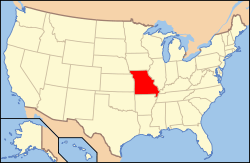Westminster College (Missouri)
Westminster College is a private liberal arts college in Fulton, Missouri. It was established in 1851 as Fulton College. The National Churchill Museum (formerly the Winston Churchill Memorial and Library) is a national historic site located on campus. The school enrolled 658 students in 2019.[3]
_seal.png) Seal of Westminster College | |
Former names | Fulton College |
|---|---|
| Motto | Religio et scientia |
Motto in English | Faith and Knowledge |
| Type | Private |
| Established | 1851 |
| Endowment | $56.6 million[1] |
| President | Donald P. Lofe |
Academic staff | 67 |
Administrative staff | 110 (Fall 2016) [2] |
| Students | 658 (2019) [3] |
| Undergraduates | Approx. 717 (700 FTE) |
| Location | , , United States |
| Campus | Rural town, 86 acres (0.13 sq mi; 34.80 ha) |
| Colors | Navy blue, light blue, and white[4] |
Sporting affiliations | NCAA Division III – SLIAC |
| Mascot | Winston Blue Jay |
| Website | www |
 | |
History
1851–1999
Westminster College was founded as a college for young men by the Rev. William W. Robertson and local Presbyterians in 1851 as Fulton College and assumed the present name in 1853. Throughout the next century, Westminster College continued to be an all-male institution until the first coeducational class in 1979.[5]
In 1909, the original Westminster Hall was destroyed by fire, leaving only the six Corinthian columns which helped support it. Since then, the Columns have been restored and serve as a symbolic rite of passage for new and graduating students. During the convocation ceremony at the beginning of students' freshman year, students walk through the columns towards the campus, and then back through towards Westminster Avenue after their graduation ceremony at the end of their senior year.[6]
Westminster College was the site of former United Kingdom Prime Minister Winston Churchill's famous "Sinews of Peace" speech in 1946. Less than one year after the end of World War II, Churchill lectured about the state of world political affairs, notably regarding the growing tension in Europe during the prelude to the Cold War.[5]
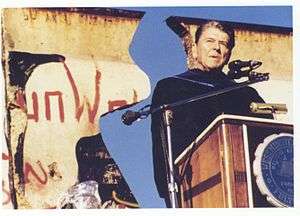
| Wikisource has original text related to this article: |
From Stettin in the Baltic to Trieste in the Adriatic an "iron curtain" has descended across the continent. Behind that line lie all the capitals of the ancient states of Central and Eastern Europe. Warsaw, Berlin, Prague, Vienna, Budapest, Belgrade, Bucharest and Sofia; all these famous cities and the populations around them lie in what I must call the Soviet sphere, and all are subject, in one form or another, not only to Soviet influence but to a very high and in some cases increasing measure of control from Moscow.
In 1969, Westminster College dedicated one of its most recognizable landmarks – the Church of St. Mary the Virgin, Aldermanbury. Originally built in the City of London in the 12th century, it was destroyed during the Great Fire of London in 1666. It was rebuilt by Christopher Wren in 1677, and then was gutted by the Blitz in 1940. It stayed in London until 1966, when it was transported stone-by-stone to Fulton and reassembled on the Westminster College campus. The undercroft of the Church is now home to the National Churchill Museum.
Also in 1969, Westminster College became independent of the Presbyterian Church[7] but maintains a loose affiliation with the Presbyterian Church (USA).
2000–present
The endowment grew from $27 million in 2000[8] to its current $56.6 million. Westminster began offering online classes in 2011.[9] The Churchill Institute for Global Engagement was created in 2013 to further global education with new academic programs and global initiatives. This period also saw the establishment of new corporate and academic partnerships, including a dual-degree program agreement with Washington University in St. Louis.[10]
Presidents
From its founding in 1851 through 1954 and again from 1861 to 1864, the college was overseen by the chairmanship of the faculty, which rotated among faculty members, instead of a president.[11] The following have served as presidents of Westminster College:
- Rev. Samuel S. Laws, 1855–1861
- Rev. John Montgomery, 1864–1865
- Rev. Michael Montgomery Fisher, 1865–1868 (acting)
- Dr. Nathan L. Rice, 1868–1874
- Rev. Michael Montgomery Fisher, 1875–1877
- Rev. Charles Campbell Hersman, 1878–1887
- Rev. William Hoge Marquess, 1888–1892
- Edward Clifford Gordon, 1894–1897 (interim)
- John Jay Rice, 1898–1899 (interim)
- Dr. John Henry McCracken, 1899–1903
- John Jay Rice, 1903–1904 (interim)
- Rev. David Ramsey Kerr, 1904–1911
- Rev. Charles Brasee Boving, 1912–1914
- John Jay Rice, 1914–1915 (interim)
- Rev. Elmer Ellsworth Reed, 1915–1926
- Dr. Marion Edmund Melvin, 1927–1933
- Dr. Franc Lewis McCluer, 1934–1946
- Rev. William Webster Hall, 1947–1954
- Robert L. D. Davidson, 1955–1973
- Dale Purcell, 1973–1976
- William L. Stucker, 1976–1977 (interim)
- John Harvey Saunders, 1977–1992
- John E. "Jack" Marshall, 1992–1993 (interim)
- James F. Traer, 1993–1999
- Neal Creighton, 1999–2000 (interim)
- Fletcher M. Lamkin, 2000–2007
- George B. "Barney" Forsythe, 2007–2015
- Benjamin Ola. Akande, 2015–2017
- Carolyn Perry, 2017 (acting)
- Fletcher M. Lamkin, 2017–2020
- Donald P. Lofe, 2020-present[11]
Academics
Academic Divisions and Departments include Humanities, Natural and Mathematical Sciences, and Social Sciences. The college offers 33 majors, 41 minors, 3 specialty programs, and 3 dual-degree programs.[12] Westminster's Cadaver Program, beginning as a small independent study in the Fall of 2005, is offered for pre-med, biology, and psychology students, who can explore the anatomy of the human body through scientific dissection.
Accreditations
Westminster College is a member of the Higher Learning Commission (HLC) and is regionally accredited by HLC. Westminster College's business program is accredited by the Accreditation Council for Business Schools & Programs (ACBSP); Westminster College's education program is accredited by the Missouri Department of Secondary Education (DESE).
Pre-professional programs
The pre-professional programs at Westminster are Dual-Degree Engineering with Washington University in St. Louis or Missouri University of Science and Technology,[13] Dual-Degree Nursing with the Goldfarb School of Nursing at Barnes-Jewish College,[14] Dual-Degree Chiropractic with Logan University College of Chiropractic,[15] Health Professions, and Legal Professions.
Academic and Corporate Partnerships
Westminster has partnered with Washington University in St. Louis to create a 4+1 Master's in Accounting program. Students earn a liberal arts degree from Westminster in four years, then complete one year of study at the Olin School of Business at Washu to receive their MA degree. A partnership with Maryville University in St. Louis allows students to earn an accelerated Master's in Business Administration. Westminster has also partnered with Ameren UE in Missouri and Illinois to offer continuing education and degree completion programs for the Ameren's employees.
Mentoring program and seminar
All incoming students are provided with two seminar mentors and a seminar professor who will advise students throughout their years at Westminster College. To make the transition from high school to college easier, mentors help orient students to their new life at Westminster and provide guidance in the areas of academics, social and residential life.
Campus
Westminster College Historic District | |
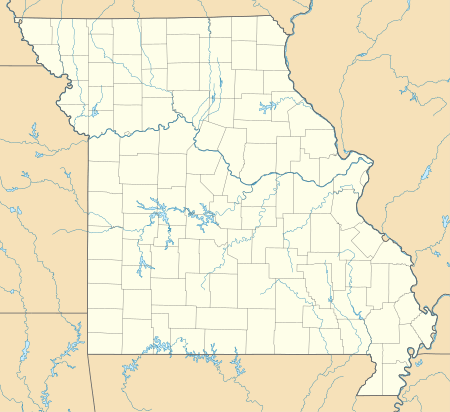  | |
| Location | Off Westminster Ave., Fulton, Missouri |
|---|---|
| Area | 18 acres (7.3 ha) |
| Architect | Multiple |
| Architectural style | Colonial Revival, Classical Revival |
| NRHP reference No. | 82004633[16] |
| Added to NRHP | April 12, 1982 |
The Westminster College Historic District was added to the National Register of Historic Places in 1982.[16] It encompasses nine contributing buildings and six contributing objects. They include the Hall of Science (1900–1901), Steam Heating Plant (1919–1920), The Columns ("Old" Westminster Hall) (1853–1854), Westminster Hall (1909–1911), the Gymnasium (1928), Swope Chapel Memorial (1967), Washington West House (1907), Re-Union Hall (1903), and Reeves Library (1950–1951).[17]
Historic Westminster Gymnasium
The Gym was built in 1928 and completely renovated in 1972. This national historic landmark is where Winston Churchill presented his Iron Curtain Speech in March 1946. Vice President Dick Cheney also visited the college during the 2004 campaign and spoke in the Gym. When new bleachers were installed, the old bleachers were recycled into new lockers for the men's and women's locker rooms. The floor has been renamed for Henry “Hank” Iba, Class of 1927, who was an all-state basketball, football and baseball player at Westminster before going on to coach Oklahoma State University to two national basketball titles and the U.S. Olympics basketball team to two gold medals. The Gym houses a basketball/volleyball court, athletic offices, and an exercise room. It also housed an indoor swimming pool until 2016.
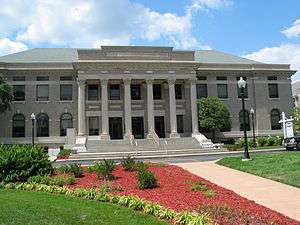
Westminster Hall
This hall was built in 1911 and renovated in 1973–74. It is the main administrative building on campus and houses the Business Office, the Dean of Student Life offices, the Registrar, the Study Abroad Coordinator, and Dean of Faculty offices along with two classrooms. The lower level houses Westminster's Health and Counseling Services, and Learning Opportunities Program.
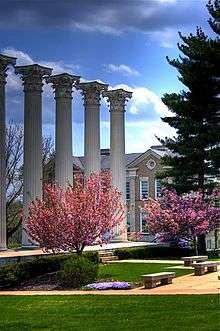
The Columns
These columns are the only remains of the first Westminster Hall built in 1854 and destroyed by fire in 1909. These Columns are the center of a campus tradition, the Columns Ceremony.
Newnham Hall
It was originally built in 1901 and is the oldest building on campus. It was completely renovated and remodeled in early 1970 as a gift of an alumnus. This building houses several classrooms plus some faculty offices. Greg Richard Resource Center—Office of Career Services is located in the basement; a gift from alumnus and trustee.
Reeves Library and Hazel Wing
Reeves Library was built in 1951 and expanded & renovated in 1981 and again in 1996. This building houses a collection of more than 100,000 volumes readily available in-house for students and faculty. It is a member of the statewide consortium of 50 academic libraries. The Hazel Wing was dedicated in October 1996 and serves as the technological center on the campus, housing four computer labs, video editing equipment, a multimedia classroom, a language lab, small group meeting, and study rooms as well as offices for the Department of Information Technology. Also located in this building is the writing/math lab.
Hunter Activity Center
Otherwise known as the "HAC", this building is a common area for both faculty and students. Downstairs is the Johnson College Inn (known to students as "JCI") grill/snack bar which is surrounded by ping-pong tables, pool tables, campus mailboxes, and the TV lounge. Upstairs houses meeting rooms and the HAC Gym. Westminster's HAC Gym includes a racquetball court, indoor track, weight equipment and workout room and is the site for most intramural sports.
Coulter Science Center
This building was renovated in 2004 with an $18 million gift from the Wallace H. Coulter Foundation. Otherwise known as "CSC," this is where science classes and labs such as chemistry, biology, physics, psychology, environmental science, computer science, and math are held. This building is complete with computer labs on every floor. Westminster faculty were asked to provide their input before architects were hired to draw up the plans. The focus is totally on students and how to create a better learning atmosphere and to offer rooms for student research on a large scale.
Champ Auditorium
This large building was built in 1966 and seats 1,400 people for concerts, lectures, music productions, and other college events such as Commencement and Freshmen Convocation.
Breakthrough
Breakthrough is a sculpture consisting of eight sections of the Berlin Wall. It commemorates the collapse of the Iron Curtain and the end of the Cold War. The sculpture is the work of artist Edwina Sandys, granddaughter of Winston Churchill.[18] It was dedicated to Westminster College in 1990 by former President Ronald Reagan. It is the longest contiguous section of the Berlin Wall in North America.
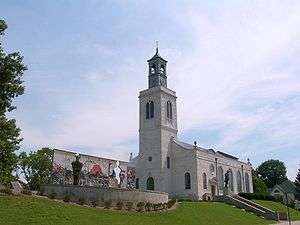
Church of St. Mary, Aldermanbury
This predecessor of this church building was originally constructed in the City of London during the 12th century, but burned down in the Great Fire of London in 1666. This church was erected as its replacement by Christopher Wren in the 17th century. During World War II, the Wren church was gutted by German bombs and in the mid-1960s, it was dismantled and shipped stone-by-stone to Fulton and reconstructed on Westminster's campus. Today, the church serves as the College's chapel. While it is occasionally claimed that St. Mary's is the oldest church in North America, the statement is not accurate. The transported Wren building is not the original 12th Century building of the St. Mary Aldermanbury parish of London. It is instead the replacement that was built under Wren's direction between 1672 and 1677, and contains no details of the original, being a new construction made largely of Portland stone that Wren had quarried in Dorset. This would make it considerably newer than such ancient North American buildings as the church of San Francisco in Tlaxcala, Mexico, whose construction began in 1521.
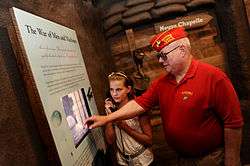
National Churchill Museum
Located below the Church of St. Mary, Aldermanbury, this state-of-the-art museum is devoted to Sir Winston Churchill. In 2005, the building underwent a $4 million renovation and reopened in March 2006, marking the 60th anniversary of Churchill's speech at Westminster. This museum features interactive exhibits about Churchill, World War II, Sir Christopher Wren and the Church of St. Mary, Aldermanbury. The Museum also showcases traveling and temporary exhibits, archival resources for scholarly research and a gift shop with unique “Churchillian” merchandise.[19]
Residential life
Westminster College manages and maintains nine residence halls as well as a limited number of residential homes for student occupancy. In addition, the five national fraternities for men operate their own independent living units. New students are generally assigned to Gage, Marquess, Rice, Scott and Sloss Halls, which compose the Churchill Quadrangle. Westminster's upper-class students live either in one of the four upperclass residence halls (Emerson, Wetterau, Weigle, Sweazey), Westminster Apartments, an on-campus residential house, Westminster Townhouses or a national fraternity house.
Student life
| 2018 student demographics[20] |
|---|
| Approx. 717 degree-seeking students |
| 56% male |
| 44% female |
| 7% of student body composed of international students |
Clubs and organizations
Westminster students can pick from over 50 clubs and organizations to become involved in on campus.[12] Honorary societies include: Alpha Chi, Alpha Mu Gamma, Beta Beta Beta, FMA National Honor Society, Gamma Theta Upsilon, Kappa Delta Pi, Omicron Delta Kappa, Phi Alpha Delta, Phi Alpha Theta, Pi Mu Epsilon, Psi Chi, Phi Sigma Alpha, Phi Sigma Tau, Sigma Tau Delta, and Theta Alpha Kappa.[21]
Greek life
Westminster College has a well-established history of Greek Life, dating to 1868. 43% of students are members of Greek organizations. Participation in this heritage has afforded students opportunities in leadership and involvement, both on-campus and within the greater Fulton community. Greek life consists of 5 national fraternities and 3 national sororities. Fraternities and sororities receive national recognition for the successful organizations that have been formed and maintained over the last 150 years.[22]
Fraternities
Sororities
Traditions
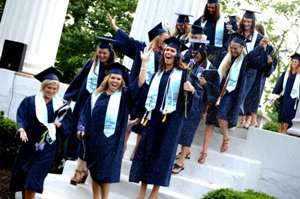
The Columns Ceremony
Six columns remain from the original college building which burned down in 1909. All students pass through the Columns as a new student and again as graduates. The first ceremony serves as a symbol of a students’ entrance into college life and the Westminster community. The other symbolizes entering the world prepared with knowledge and experience gained at Westminster.
The Skulls of Seven
The Skulls of Seven is an honor society, founded in 1898, that prides itself on its commitment to seven virtues: tradition, history, scholarship, loyalty and friendship, citizenship, service, and honor. The Skulls of Seven are defenders of college tradition and are chosen for their adherence to the seven virtues with the duty of upholding these values. These six seniors and one junior are selected based on their proven devotion to the college and their positive representation of Westminster. This society has existed for over 100 years. The continuing purpose of the Skulls is always and ever the welfare of the college.
Athletics
Westminster College is a NCAA Division III school and belongs to the St. Louis Intercollegiate Athletic Conference (SLIAC). Westminster sports include baseball, basketball (M&W), cheerleading, cross country (M&W), football, golf (M&W), soccer (M&W), softball, tennis (M&W), track and field (M&W), volleyball, and wrestling (M&W).[23]
Notable alumni
- Joe Aull
- Ewald W. Busse
- W. Bruce Cameron
- Courtney W. Campbell
- Wallace H. Coulter
- William Henry Danforth, Chancellor of Washington University in St. Louis and philanthropist
- Forrest DeBernardi
- Bill Emerson
- G. David Gearhart
- Michael Gibbons, former President Pro Tem of Missouri State Senate
- Julian Wood Glass Jr., United States District Judge of the United States District Court for the Eastern District of Missouri
- George F. Gunn Jr.
- Paul K. Holmes III
- Henry Iba, American basketball coach and college athletics administrator
- Michael Kim
- Bake McBride
- Benjamin M. Palmer
- Edward D. Robertson Jr.
- Tony F. Schneider
- Scott Shipp
- Alfred C. Sikes, former U.S. administrator of the National Telecommunications and Information Administration, who served as chairman of the Federal Communications Commission (FCC)
- Forrest Smith
- Thomas Starzl
- Howard Sutherland
- John Van Sant, Pennsylvania State Representative and State Senator
- Harry H. Vaughan (1893–1981), U.S. Army Reserve general, Aide to the President of the United States from 1945 to 1953
- Oberon Zell-Ravenheart
References
- As of June 30, 2015. "Westminster College". Regional Universities Miswest. US News & World Report. Retrieved October 14, 2016.
- "Faculty & Staff Directory". Westminster. Retrieved October 14, 2016.
- "Trends in Headcount Enrollment, 2013-2019". Missouri Department of Higher Education. Retrieved July 20, 2020.
- Westminster College Graphic Identity Standards Manual (PDF). Retrieved January 6, 2016.
- Parrish, William E. Westminster College: An Informal History, 1851–1999. Fulton, Mo: Westminster College, 2000. Print. OCLC Number 45495552
- "Campus Facilities/Campus Buildings".
- Westminster College Campus Catalog, 2002 – 2003.
- "Endowment". Archived from the original on February 19, 2014.
- "First Online Classes".
- "Washington University Partnership".
- "Westminster College - College Presidents". westminster-mo.edu. Retrieved January 4, 2018.
- "Facts About Westminster". Westminster. 2015. Retrieved October 14, 2016.
- "Westminster College - Dual-Degree Engineering". www.westminster-mo.edu. Retrieved January 4, 2018.
- "Westminster College - Dual-Degree Nursing". www.westminster-mo.edu. Retrieved January 4, 2018.
- "Westminster College - Dual-Degree Chiropractic". www.westminster-mo.edu. Retrieved January 4, 2018.
- "National Register Information System". National Register of Historic Places. National Park Service. July 9, 2010.
- Warren Hollrah, Ann Stimble, Eve Saunders, and Karen Grace (August 1980). "National Register of Historic Places Inventory Nomination Form: Westminster College Historic District" (PDF). Missouri Department of Natural Resources. Retrieved October 1, 2016.CS1 maint: multiple names: authors list (link)
- edwinasandys.com
- "Winston Churchill Museum in Fulton, MO". National Churchill Museum. November 13, 2015. Retrieved January 7, 2016.
- "Westminster College - Facts about Westminster". www.westminster-mo.edu. Retrieved January 8, 2018.
- "Archived copy". Archived from the original on May 9, 2012. Retrieved July 20, 2012.CS1 maint: archived copy as title (link)
- "Archived copy". Archived from the original on June 30, 2012. Retrieved July 20, 2012.CS1 maint: archived copy as title (link)
- "St. Louis Intercollegiate Athletic Conference". Sliac.org. Retrieved August 23, 2017.
External links
| Wikimedia Commons has media related to Westminster College (Missouri). |
- Official website

- War Comes to Westminster College – Missouri's Civil War at The Historical Marker Database (HMdb.org)
- Westminster College Athletics website
- Works by or about Westminster College in libraries (WorldCat catalog)

